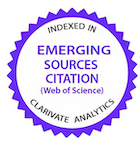Comportamento da nidificação de abelhas melíponas
DOI:
https://doi.org/10.1590/1809-6891v21e-58736Resumo
As melíponas, além de excelentes produtoras de mel, prestam um grande serviço à humanidade através da sua capacidade de polinizar plantas e sua consequente preservação de ecossistemas. Nessa relação interespecífica harmônica, as abelhas são beneficiadas pelas espécies vegetais pelo provimento do alimento (néctar e pólen), além de utilizarem seus galhos e troncos para se alojarem. Porém, a ação antrópica predatória tem colocado em risco a sobrevivência das melíponas, causando danos ambientais irreversíveis e comprometendo a preservação dos recursos naturais. Este trabalho objetivou identificar os hábitos de nidificação das abelhas nativas em condições naturais. Por meio de trilhas aleatórias na microrregião do Curimataú paraibano foi possível identificar os pontos de nidificação das espécies de meliponíneos em seu habitat natural. Foram identificados 60 ninhos de melíponas nidificando em 12 espécies vegetais diferentes, sendo a Commiphora leptophloeos a hospedeira de maior preferência (46,66%), com 55% dos orifícios de entrada apontados para orientações magnéticas entre o Nordeste e Noroeste; com maior escolha por hospedeiras (árvores) [85%]; apresentando preferência por nidificação em vegetais hospedeiros com circunferência de 0,98 m de diâmetro, orifício de entrada dos ninhos com 7,77 mm de diâmetro e uma altura do solo de 1,52 m; Os dados obtidos revelam pouca variedade de espécies melíponas na região Curimataú paraibano, com destaque para Melipona subnitida. As espécies Melipona asilvae, Melipona scutellaris, Partomona seridoenses e Plebeia sp. devem ter uma atenção especial para não entrarem em extinção nessa região.
Palavras-chave: Curimataú. Habitat natural. Melíponas. Nidificação. Preferência.
Downloads
Referências
Silva CI. Guia ilustrado de abelhas polinizadoras no Brasil. Universidade de São Paulo (USP). 1a Edição. São Paulo – SP, 2014. 2. Palazuelos-Ballivián JMP. (Org.). Abelhas nativas sem ferrão. São Leopoldo: Oikos; 2008. 128 p. 3. Posey D. Folk Apiculture of the Kayapó Indians of Brazil. Biotropica, [S.I.]. 1983;15(2):154–158. 4. Danforth BN. et. Al.The history of early bee diversification based on five genes plus morphology. Proceedings of the National Academy of Sciences of United States of America. 2006;103(41):15118-23. 5. Klein AM. et.al. Importance of pollinators in changing landscapes for world crops. Proceedings. Biological sciences / The Royal Society. 2007;274(1608):303-13.
FAO. Conservation and management of pollinators for sustainable agriculture - the international response. In: Solitary bees: conservation, rearing and management for pollination. Imprensa Universitária: Fortaleza. p.19-20;2004. 7. Allen-Wardell G. et al. The potential consequences of pollinator declines on the conservation of biodiversity and stability of food crop yields. Conservation Biology. 1998; 12(1):8-17. 8. Kevan P. Pollinators as bioindicators of the state of the environment: species activity and diversity. Agriculture Ecosystems and Environment, v. 74, p. 373-393, 1999. 9. Lopes, M. Abelhas sem ferrão: a biodiversidade invisível. 2005. Disponível em: http://www. agriculturesnetwork.org/magazines/brazil/4-criacao-de-pequenosanimais/abelhas-sem-ferrao-a biodiversidade-invisivel/at_download/article_pdf. Acesso em: 01 de Jul de 2017. 10. Foley JA. et. Al. Global consequences of land use. Science. 2005;309(5734):570-4. 11. Parmesan C. et.al. Poleward shifs in geographical ranges of butterfly species associated with regional warming. Nature. 1999;399(6736):579-583. 12. Kerr WE et al. Aspectos pouco mencionados da biodiversidade amazônica. Parcerias Estratégicas, v.12, p.20-41, 2001. 13. Kerr WE. Extinção de espécies: A grande crise biológica do momento e como afeta os meliponinios. In: V ENCONTRO SOBRE ABELHAS, 5, 1996, Ribeirão Preto, SP. Anais... Ribeirão Preto, SP, 2002, p. 4-9. 14. Castro MS. A Comunidade de abelhas (Hymenopetra, Apoidea) de uma área de caatinga arbórea entre os inselbergs de Milagres (12º53´S; 39º51´W), Bahia. 2001. (Tese Doutorado em Ecologia), Instituto de Biociências, Universidade de São Paulo. São Paulo, SP. 191p. 15. Câmara JQ. Estudos preliminares da abelha Jandaíra (Melipona subnitida D.) no município de Jandaíra – RN. Mossoró-RN: ESAM. 2004. 16. Leal IR. et al. Ecologia e conservação da Caatinga. Editora Universitária, Universidade Federal de Pernambuco, Recife, Brasil. 2003. 17. Freitas BM. et al. Diversity, threats and conservation of native bees in the Neotropics. Apidologie. 2009;40:332–346. 18. Nogueira-Neto P, Sakagami SF. Nest Structure of a Subterranean Stingless Bee – Geotrigona mombuca Smith (Meliponinae, Hymenpotera: Apoidea). An. Acad. Bras. de Ciências, [s.l.]. 1966;38(1):187-194. 19. Kerr WE. et al. Observações sobre a arquitetura dos ninhos e comportamento de algumas espécies de abelhas sem ferrão das vizinhanças de Manaus, Amazonas (Hymenoptera : Apoidea). Atas. Simp. Biota Amazônica, Manaus, AM, n. 5 (Zoologia), p. 255-309, 1967. 20. Laroca S, Almeida MC. Coexistência entre abelhas sem ferrão e formigas: Ninho de Paratrigona myrmecophila (Apidae) construído em ninho de Camponotus senex (Formicidae). Revta. Bras. Zool., Curitiba, PR.1989;6(4):671-680. 21. Imperatriz-Fonseca VL. et al. Subterranean nest structure of a stingless bee (Paratrigona subnuda Moure) (Meliponinae, Apidae, Hymenoptera). Ciência e Cultura, São Paulo, SP. 1972;24(7):662-666. 22. Camargo JMF. Biogeografia de Meliponini (Hymenoptera, Apidae, Apinae): a fauna Amazônica. In: ENCONTRO SOBRE ABELHAS, 1, 1994, Ribeirão Preto - SP, Anais... São Paulo, SP: USP, 1994, p. 46:59. 23. Nogueira-Neto P. et al. Biologia e manejo das abelhas sem ferrão. São Paulo, SP: Edição Tecnapis, 1986, 54p.
Vossler GG. Flower visits, nesting and nest defence behaviour of stingless bees (Apidae: Meliponini): suitability of bee species for meliponiculture in the Argentinean Chaco region. Apidologie. 2012;43:139- 161. 25. Abraçado L. et al. “Magnetic material in head, thorax, and abdomen of Solenopsis substituta ants: A ferromagnetic resonance study”, Journal of Magnetic Resonance. 2005;175(2):309-316. 26. Walker M. “A model for encoding of magnetic field intensity by magnetite-based magnetoreceptor cells”, Journal of Theoretical Biology. 2008;250(1):85-91. 27. Begal S. et al. “Magnetic alignment in mammals and other animals”, Mammalian Biology.2013;78(1):10-20. 28. Anderson JB, Vander Meer RK. Magnetic orientation in the fire ant, Solenopsis invicta. Naturwissenschaften 80, 568-570. 1993. 29. Menezes H. Própolis: uma revisão dos recentes estudos de suas propriedades farmacológicas. Arquivos do Instituto Biológico. 2005;72(3):405-411. 30. Bruening H.; Abelha Jandaíra. 3a ed. Natal: SEBRAE/ RN, 2006. 31. Serra BD. V. Abundância, distribuição espacial de ninhos de abelhas Meliponina (Hymenoptera, Apidae, Apini) e espécies vegetais utilizadas para nidificação em áreas de cerrado do Maranhão. Iheringia, Série Zoologia. 2009;99(1):12-17. 32. Kerr W. E. et al. Abelha Uruçu : Biologia, Manejo e Conservação – Belo Horizonte-MG: Acangaú, 1996. 144 p.: il., (Coleção Manejo da vida silvestre; 2). 33. Rosso L. J. M. et al. Meliponicultura em Brasil I: situacion em 2001 y perspectivas. In: Seminário Mexicano sobre Abejas sin Aguijón, 2., Yucatán, 2001. Anais... Yucatán, 2001. p. 28-35. 34. Campos LAO, Peruquetti RC. Biologia e criação de abelhas sem ferrão. Informe Técnico. Viçosa: UFV. 1999; n. 82, 38p. 35. Camargo JMF, Pedro SRM. Meliponini Lepeletier, 1836. In Moure, J. S., Urban, D., Melo, G. A. R. (Orgs). 2013. Catalogue of Bees (Hymenoptera, Apoidea) in the Neotropical Region - online version. Disponível em: http://www.moure.cria.org.br/catalogue. Acessado em 05/07/2017 36. Waldschmidt AM. Meliponicultura na Bahia. In: Congresso Baiano de Apicultura, 2. 2002, Paulo Afonso, BA. Anais... Paulo Afonso: p. 166-168. 2002. 37. Sakagami SF. Stingless bees. In: Herman, H. R. ed. Social Insects III. London, Academic Press, p. 361- 423, 1982. 38. AQUINO IS. Abelhas Nativas da Paraíba. 1ª edição. João Pessoa. Editora Universitária - UFPB. 2006. 91p. 39. Lorenzon MCA. et al. Flora visitada pelas abelhas eussociais (Hymenoptera, Apidae) na Serra da Capivara, em caatinga do Sul do Piauí. Neotropical Entomology. 2003;32(1):27-36. 40. Martins CF.et al. Espécies arbóreas utilizadas para nidificação por abelhas sem ferrão na caatinga (Seridó, PB; João Câmara, RN). Biota Neotropica. 2004;4(2):1-8. 41. Antonini Y. Efeitos de variáveis ecológicas na ocorrência de Melipona quadrifasciata (Apidae, Meliponini) em fragmentos urbanos e rurais. 2002. Tese de doutorado, Universidade Federal de Minas Gerais, Belo Horizonte. 42. Ferreira R.LC, Vale AB. Subsídios básicos para o manejo florestal da caatinga. Anais do 2º CongressoNacional sobre Essências Nativas:368-375. 1992. 43. Villas-Bôas J. Manual Tecnológico: Mel de Abelhas sem Ferrão. Brasília – DF. Instituto Sociedade, População e Natureza (ISPN). Brasil, 2012. 44. Werneck HA.; Faria-Mucci GM. Abelhas sem Ferrão (Hymenoptera:Apidae, Meliponini) da Estação Ecológica de Água Limpa, Cataguases-MG, Brasil. EntomoBrasilis. 2014;7(2):164-166. 45. Pedro SRM.; Camargo JM. F. Meliponini Neotropicais: o gênero Partamona Schwarz, 1939 (Hymenoptera, Apidae). Revista Brasileira de Entomologia, 47(supl. 1): 1-117. 2003. 46. Pioker-Hara FC. Determinantes da densidade e distribuição de ninhos e diversidade de espécies de meliponineos (Apidae, Meliponini) em áreas de cerrado de Itirapina, SP. Tese de doutorado em Ecologia. Universidade de São Paulo, USP, Brasil. 2011. 47. Lacerda DC. O. Influência da Orientação Magnética na Nidificação de Abelhas Nativas na Zona da Mata Pernambucana. 2017. Dissertação (Mestrado em Ciências Agrarias “Agroecologia”). Universidade Federal da Paraíba-UFPB, Bananeiras-PB, 77p. 48. Souza SGX. et. al. As abelhas sem ferrão (Apidae; Meliponina) residentes no campus Federação/ Ondina da Universidade Federal da Bahia, Salvador. Candombá - Revista Virtual. 2005;1(1):57–69. 49. Silva FJA. Preferência de Nidificação em Abelhas Indígenas. 2016. Dissertação (Mestrado em Ciências Agrarias “Agroecologia”). Universidade Federal da Paraíba-UFPB, Bananeiras-PB, 90p.
Downloads
Publicado
Como Citar
Edição
Seção
Licença
Copyright (c) 2020 Ciência Animal Brasileira

Este trabalho está licenciado sob uma licença Creative Commons Attribution 4.0 International License.
Autores que publicam nesta revista concordam com os seguintes termos:
- Autores mantém os direitos autorais e concedem à revista o direito de primeira publicação, com o trabalho simultaneamente licenciado sob a Licença Creative Commons Attribution que permite o compartilhamento do trabalho com reconhecimento da autoria e publicação inicial nesta revista.
- Autores têm autorização para assumir contratos adicionais separadamente, para distribuição não-exclusiva da versão do trabalho publicada nesta revista (ex.: publicar em repositório institucional ou como capítulo de livro), com reconhecimento de autoria e publicação inicial nesta revista.
- Autores têm permissão e são estimulados a publicar e distribuir seu trabalho online (ex.: em repositórios institucionais ou na sua página pessoal) a qualquer ponto antes ou durante o processo editorial, já que isso pode gerar alterações produtivas, bem como aumentar o impacto e a citação do trabalho publicado (Veja O Efeito do Acesso Livre).






























